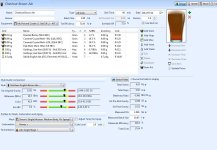I am using a trail version of BS2 until I get familiar with the workings.
What I cant figure out is how to build my equipment profile. My standard technique is low volume brewing as per the Brooklyn Brew Shop's AG kits (but am now exploring my own recipes)
Essentially this is a mash using a 1 gallon SS pot, and a separate sparging. So how do I build my equipment profile considering that I have a mash of around 2-3quarts, and add to that a gallon of sparge water, and ending up with a final volume slightly under 1 gallon, which is then topped up to the full gallon in the fermenter.
So this isn't BIAB, and neither is it a mash tun (actually I dont know what the proper terminology for this technique is
What I cant figure out is how to build my equipment profile. My standard technique is low volume brewing as per the Brooklyn Brew Shop's AG kits (but am now exploring my own recipes)
Essentially this is a mash using a 1 gallon SS pot, and a separate sparging. So how do I build my equipment profile considering that I have a mash of around 2-3quarts, and add to that a gallon of sparge water, and ending up with a final volume slightly under 1 gallon, which is then topped up to the full gallon in the fermenter.
So this isn't BIAB, and neither is it a mash tun (actually I dont know what the proper terminology for this technique is


